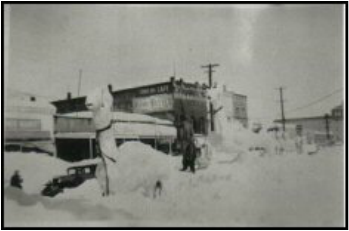Unforgettable Winter Storms
|
The winter of 1907 produced 20-foot snowdrifts. The biggest storm came with wet, heavy snow that snapped the power lines on Donner Summit, plunging Truckee, Reno, Carson City and Virginia City into an eerie darkness. By the time spring arrived, a record 884 inches of snow had fallen in the Sierra.
In 1916, another mammoth snowstorm descended upon northern California. By January 1st, snow was reported as far as Oakland and Fresno. In the Sierra, the blizzard raged on for 48 hours dropping nearly five feet of snow in downtown Truckee and 13 inches in Reno.
The “Friday the 13th Storm” of November, 1931, was the first of a series of brutal winter storms that brought 54 inches of continuous snow for five days, bringing below zero temperatures with it. By the time winter was over, 600 inches of snow had fallen in the Sierra.
Most old-timers agree that the “Mother of all Storms” was the Blizzard of 1952. Weather historian, Mark McLaughlin, refers to it as “the winter that overwhelmed everyone.” In one furious storm, lasting from January 10 to January 17, Donner Summit recorded 154 inches of snow. 80 mph winds blew forty-foot deep snowdrifts, burying homes and cars.
1952 was the year that the 15-car luxury streamliner, the “City of San Francisco,” became snowbound near Yuba Pass, stranding 196 passengers and a crew of 30. The storm raged on so fiercely that two days passed before the first contact from outside came. Nearly a week passed before the passengers were finally rescued. The rescue was the subject of news headlines worldwide.
Many old timers remember the winter of 1952 when people used the second-floor windows of their homes as the front door. Smaller homes were totally buried beneath the snow.
Most of Truckee’s old-time residents are in agreement that winters in the first half of the century were colder and had much greater snowfalls than today.
Frank Titus, Jr. attended school in Truckee between 1927 and 1938. “I chuckle at today’s storms,” he says. “When I hear about the schools closing, I have to laugh. I remember that we went to school on skis over six feet of snow.”
The old Truckee High School was located west of the present site of the Veterans Building. “When the snow got deep, the teachers who lived in town would wait for the children to clear a path up the hill to the school before venturing out themselves,” says Titus. “If we didn’t clear a path for them, the teachers could not have made it to school.”
Titus also recalls the power outages in those days. “We kept ourselves prepared for winter,” he says. “We always had kerosene lanterns. We anticipated being snowed in.”
“Our house had a wood stove in the kitchen,” Titus recalls. “There were no hot water heaters. Hot water was generated through coils in the wood stove that went into a 40 or 50 gallon tank in the bathroom, so you could always have a hot bath.”
In a 1982 interview, eighty six year old Everet Parker shared his memories of past winters in Truckee. Some of his comments are worth repeating:
“Roads were not plowed back in the 1920s like they are today. People would walk, skied or ride horse-drawn sleighs to get where they were going. The roads lay covered with snow from November until late June. After the snow hardened, you just walked on top of it.”
“In 1911 the snow was so deep that a tunnel had to be dug in the snow across Donner Pass Road from the train depot to the shops on Commercial Row,” said Parker.
With the winter outdoors fun came the tourists. Old highway 40 was usually closed during the winter and, because of the snow, the only way in or out of town was by train. Weekend visitors often stayed on the trains overnight, enjoying all the comforts of the Southern Pacific.
“Snow sculptures lined Commercial Row,” recalled Parker. “Large sculptures of every kind delighted children and amazed visitors to Truckee.”
“Even the U.S. mail was delivered by sleigh,” according to Parker. “Sleigh horses were fitted with small snowshoes that allowed them to go over snow banks,” he said.
“People didn’t let heavy snow affect their activities,” Parker said. “Bonfires on Donner Lake to warm ice skating parties were a popular way of warding off the winter chill.”
Whether Truckee winters were milder or more severe during the first half of the century remains a subject for lively debate.

